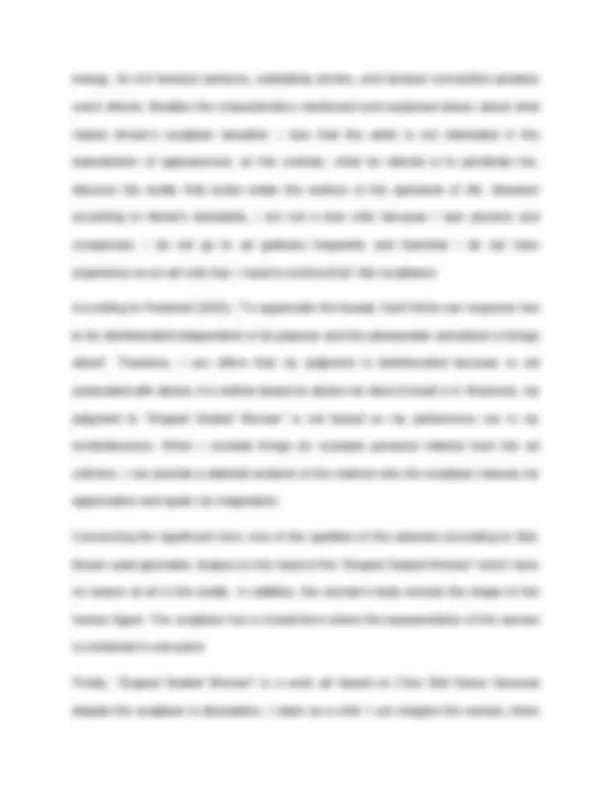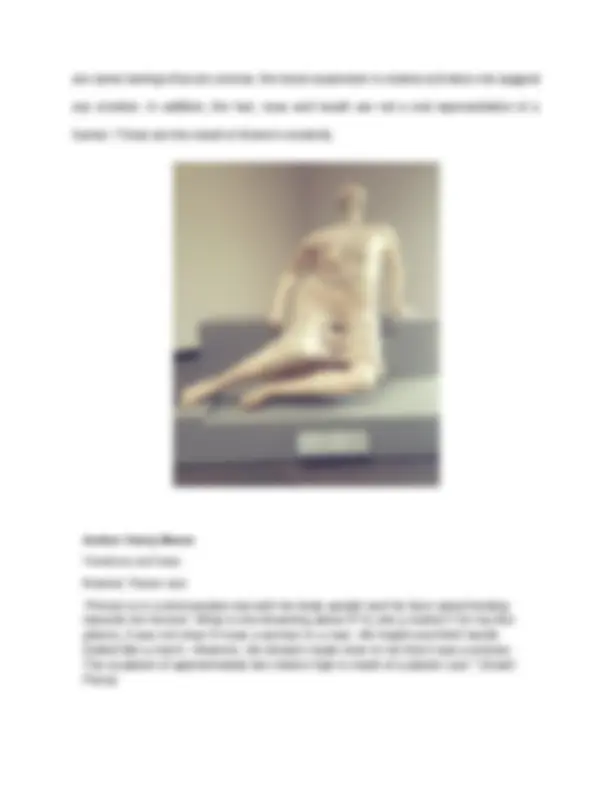





Study with the several resources on Docsity

Earn points by helping other students or get them with a premium plan


Prepare for your exams
Study with the several resources on Docsity

Earn points to download
Earn points by helping other students or get them with a premium plan
Community
Ask the community for help and clear up your study doubts
Discover the best universities in your country according to Docsity users
Free resources
Download our free guides on studying techniques, anxiety management strategies, and thesis advice from Docsity tutors
An in-depth analysis of henry moore's sculpture 'draped seated woman.' the author shares their initial observations and interpretations of the sculpture, which they believe represents a tired and hopeful woman. The document also includes information about the artist's background, his artistic influences, and the critical reception of his work. The author also discusses the sculpture's formal qualities and how it relates to clive bell's theory of significant form.
Typology: Essays (university)
1 / 5

This page cannot be seen from the preview
Don't miss anything!




Since the earliest times, man has had the need and the opportunity to sculpt, at first they did it with the easiest materials to get and work: mud and wood, but later they were learning to work materials such as stone and metals, this experimentation and search for new materials and sculptural techniques have lasted until the actuality. Walking through the Art Gallery of Ontario with my son the sculpture showed in Figure 1 calls my attention. It is inevitable to know that Henry Moore is the artist behind it. However, the title is unknown for me I will call “Tiredness and hope” because the person is in a tired position but with his body upright and his face raised looking towards the horizon. What is she dreaming about it? Is she a mother? On my first glance, it was not clear if it was a woman or a man. His height and thick hands looked like a man's. However, the breasts made clear to me that it was a woman. The sculpture of approximately two meters high is made of a plaster cast. Now once, I have read the label of the piece the title given by Henry Moore is “Draped Seated Woman”. It is different; the title is very simple. The artwork is amazing and the piece of art allows the critic to ask a lot of questions but the title is not creative, the title mentions characteristics that are seen in the sculpture. The artwork was donated by the artist in 1974 and indeed it is made in a plaster cast. Henry Moore, considered one of the great artists of the century, had a random life, which even led him Figure 1. Tiredness and hope
to participate during the First World War, as a member of the London Regiment 15, in the Battle of Cambray, in which he suffered serious injuries when He was only 19 years old (1917). In 1940, his studio in Hampstead was bombed during World War II and he had to move to a farm in Perry Green, near Much Hadham, in Hertfordshire (The Henry Moore Foundation). Moore, the British sculptor, was related since 1930 with all- important artistic movements that took place in Britain and in general in almost all of Europe: although he never got to commit to none of them, moreover, parallel to these created a personal form that it took elements from some of them, although it also showed the influence of primitive cultures, mainly of pre-Columbian. In the work Draped Seated Woman a sculpture of abundant proportions can be observed, but with sinuous and curved styles. It is a sculpture that encourages to be touched, to feel all the beauty that inspires the feminine, and when I say beauty I do not mean a face or body shown by a consumerist society because the true beauty of the woman is manifested in the greatness of her soul, from where her spiritual wealth shines, her fortitude in the face of pain, her dedication to serving and his inexhaustible capacity to love. Moreover, the face of the sculpture looks to the left, with a hopeful expression, as if waiting for that moment in which the horrors of the second war are over. The viewer can move around for appreciation complete. The erect back represents the ability of the human being to overcome disasters, such as caused by war. However, the sitting position demonstrates physical exhaustion. The piece is proportioned irregularly due to the small head in comparison with the body. Within the dark floor of the gallery and the light that goes through the glass, the volume and gigantic proportions of the sculpture is more clearly appreciated. Overflowing with latent
are some feelings that are unclear, the facial expression is neutral and does not suggest any emotion. In addition, the hair, nose and mouth are not a real representation of a human. Those are the result of Moore’s creativity. Author: Henry Moore Tiredness and hope Material: Plaster cast “Person is in a tired position but with his body upright and his face raised looking towards the horizon. What is she dreaming about it? Is she a mother? On my first glance, it was not clear if it was a woman or a man. His height and thick hands looked like a man's. However, the breasts made clear to me that it was a woman. The sculpture of approximately two meters high is made of a plaster cast.” (Soath Parra)
Bibliography The Henry Moore Foundation. A Rise to Fame. Retrieved February 26, 2020, from https://www.henry-moore.org/about-henry-moore/biography/a-rise-to-fame Freeland, C. (2001). Bu is it art? New York, Oxford University Press Inc.